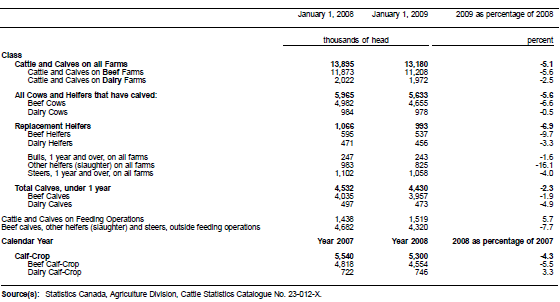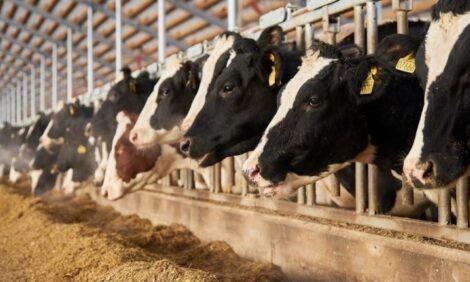



Canadian Cattle Statistics - February 2009
The US COOL (Country of Origin Labelling) legislation has created uncertainties in the marketplace for Canadian cattle producers, reports Statistics Canada. .Highlights
- Canadian cattle producers reported 13.2 million head as of 1 January this year, down 5.1 per cent from the previous year.
- Between 1 January 2008 and 1 January 2009, the dairy herd fell 2.5 per cent, while the beef herd fell 5.6 per cent.
- The Country of Origin Labeling legislation (COOL) in the United States created an uncertain marketplace for Canadian producers.
- Revenues for cattle and calf producers declined for the first nine months of 2008 from same period 2007.
- Rising input costs, due in part to increased feed grain prices and market uncertainty, had an impact on Canadian producers and has exerted downward pressure on profits.
Analysis
Livestock Statistics as of 1 January 2009
Farm inventories of cattle, hogs and sheep all declined between 1 January 2008 and 1 January 2009, reflecting factors such as market uncertainty and rising input costs.
Text table 1
Livestock inventories at 1 January

Cattle and calves inventory decreasing
Canadian cattle producers reported 13.2 million head as of 1 January this year, down 5.1 per cent. The national cattle inventory, which has been declining during the past four years, has returned to pre-BSE (bovine spongiform encephalopathy) levels seen in 2003.
Text table 2
Cattle and calves: number by class and calf-crop, Canada

Beef and Dairy Herds
Between 1 January 2008 and 1 January 2009, the dairy herd fell 2.5 per cent, while the beef herd fell 5.6 per cent. The beef herd shows no sign of rebuilding, as the number of cows is down 6.6 per cent and the number of replacement heifers is down 9.7 per cent.
On 1 January this year, there were 86,520 farm operations reporting beef herds, down 3.8 per cent.
Beef numbers fell last year in the four major beef producing provinces: Alberta (-3.3 per cent), Saskatchewan (-8.0 per cent), Manitoba (-6.1 per cent) and Ontario (-14.5 per cent). These declines continued long-term downward trends. Combined, these provinces accounted for 89.0 per cent of the Canadian beef herd.
For Ontario, the total cattle and calves inventory is the lowest since the data was recorded back in 1940.
Further Reading
| - | You can view the full report by clicking here. |
February 2009


